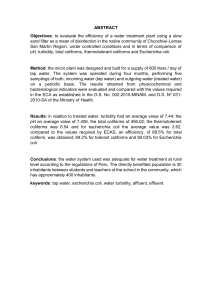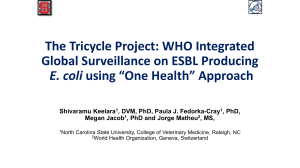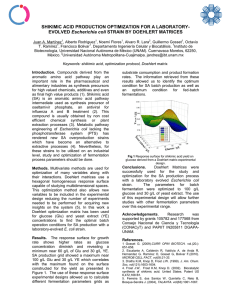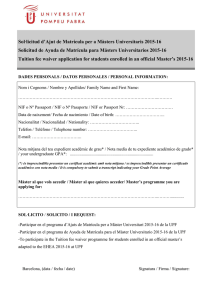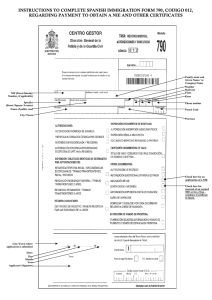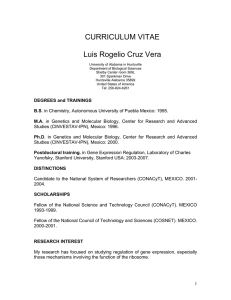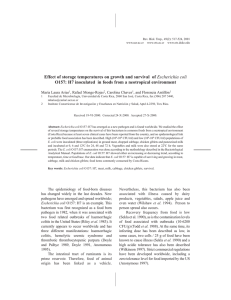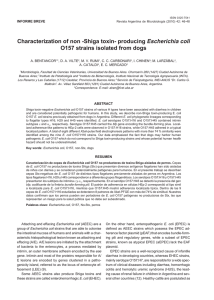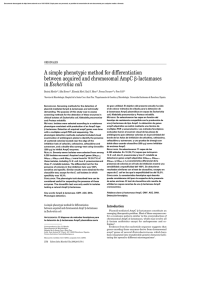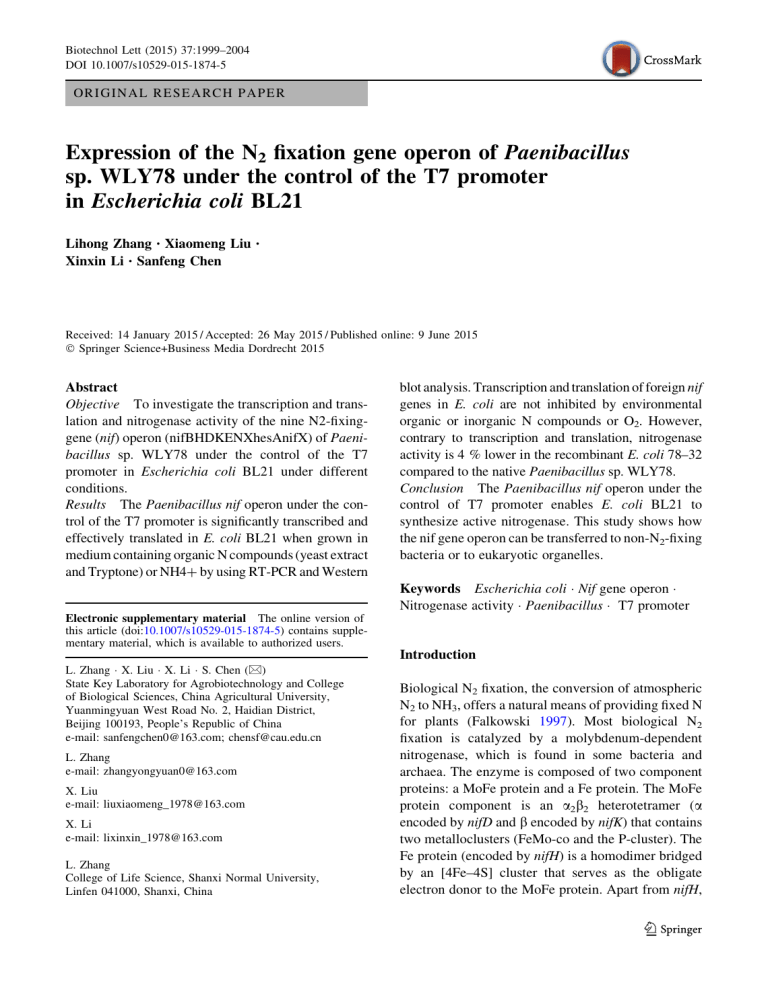
Biotechnol Lett (2015) 37:1999–2004 DOI 10.1007/s10529-015-1874-5 ORIGINAL RESEARCH PAPER Expression of the N2 fixation gene operon of Paenibacillus sp. WLY78 under the control of the T7 promoter in Escherichia coli BL21 Lihong Zhang . Xiaomeng Liu . Xinxin Li . Sanfeng Chen Received: 14 January 2015 / Accepted: 26 May 2015 / Published online: 9 June 2015 Ó Springer Science+Business Media Dordrecht 2015 Abstract Objective To investigate the transcription and translation and nitrogenase activity of the nine N2-fixinggene (nif) operon (nifBHDKENXhesAnifX) of Paenibacillus sp. WLY78 under the control of the T7 promoter in Escherichia coli BL21 under different conditions. Results The Paenibacillus nif operon under the control of the T7 promoter is significantly transcribed and effectively translated in E. coli BL21 when grown in medium containing organic N compounds (yeast extract and Tryptone) or NH4? by using RT-PCR and Western blot analysis. Transcription and translation of foreign nif genes in E. coli are not inhibited by environmental organic or inorganic N compounds or O2. However, contrary to transcription and translation, nitrogenase activity is 4 % lower in the recombinant E. coli 78–32 compared to the native Paenibacillus sp. WLY78. Conclusion The Paenibacillus nif operon under the control of T7 promoter enables E. coli BL21 to synthesize active nitrogenase. This study shows how the nif gene operon can be transferred to non-N2-fixing bacteria or to eukaryotic organelles. Keywords Escherichia coli Nif gene operon Nitrogenase activity Paenibacillus T7 promoter Electronic supplementary material The online version of this article (doi:10.1007/s10529-015-1874-5) contains supplementary material, which is available to authorized users. Introduction L. Zhang X. Liu X. Li S. Chen (&) State Key Laboratory for Agrobiotechnology and College of Biological Sciences, China Agricultural University, Yuanmingyuan West Road No. 2, Haidian District, Beijing 100193, People’s Republic of China e-mail: [email protected]; [email protected] L. Zhang e-mail: [email protected] X. Liu e-mail: [email protected] X. Li e-mail: [email protected] L. Zhang College of Life Science, Shanxi Normal University, Linfen 041000, Shanxi, China Biological N2 fixation, the conversion of atmospheric N2 to NH3, offers a natural means of providing fixed N for plants (Falkowski 1997). Most biological N2 fixation is catalyzed by a molybdenum-dependent nitrogenase, which is found in some bacteria and archaea. The enzyme is composed of two component proteins: a MoFe protein and a Fe protein. The MoFe protein component is an a2b2 heterotetramer (a encoded by nifD and b encoded by nifK) that contains two metalloclusters (FeMo-co and the P-cluster). The Fe protein (encoded by nifH) is a homodimer bridged by an [4Fe–4S] cluster that serves as the obligate electron donor to the MoFe protein. Apart from nifH, 123 2000 nifD and nifK, several other genes (nifE, N, X B, Q, V, Y, S, U, M, Z, T and W) are required for nitrogenase biosynthesis (Dixon et al. 1997). The organization and numbers of nif genes vary amongst diazotrophic species. In Klebsiella oxytoca, 20 nif genes are co-located within a 24 kb cluster (Arnold et al. 1988), whereas in Azotobacter vinelandii the nif genes are dispersed and distributed as two clusters (Jacobson et al. 1989). However, some N2fixing organisms possess a restricted nif gene set. For example, Paenibacillus sp. WLY78 contains nine nif genes nifBHDKENXhesAnifV, which are organized as an operon under a r70-dependent promoter (Wang et al. 2013a; Xie et al. 2014). The nif gene operon under the native r70-dependent promoter enabled the synthesis of catalytically active nitrogenase in E. coli JM109 (Wang et al. 2013a). In order to escape the native regulatory factors, the nif gene operon was placed under the control of T7 promoter and then was transferred into E. coli BL21, yielding the recombinant E. coli 78–32 (Wang et al. 2013a). However, the nitrogenase activity of E. coli 78–32 is much lower than that of Paenibacillus sp. WLY78. The transcription and translation of nif gene operon in E. coli 78–32 have not been studied. Here, the transcription and translation of nif genes under T7 promoter in E. coli BL21 under different conditions have been studied. Materials and methods Bacterial strains, media, and growth conditions Paenibacillus sp. WLY78 and the recombinant E. coli 78–32 were used. Paenibacillus sp. WLY78 is a N2fixing strain isolated from the rhizosphere of bamboo. E. coli 78–32 is a derivative of E. coli BL21 carrying plasmid pET-28b which contains Paenibacillus nif gene operon (nifBHDKENXhesAnifV) under control of T7 promoter (Fig. 1a. The both bacteria were routinely grown in LD medium (low salt lysogeny broth medium containing per liter: 2.5 g NaCl, 5 g yeast extract and 10 g Tryptone) with shaking at 180 rpm and 30 °C. When appropriate, 50 lM kanamycin was added for maintenance of plasmid in the E. coli 78–32. For transcriptional and translational analysis, Paenibacillus sp. WLY78 and E. coli 78–32 were grown in N-deficient medium under N2-fixing 123 Biotechnol Lett (2015) 37:1999–2004 condition (without O2 and NH4?) or non-N2-fixing condition (21 % O2 and 100 mM NH4?). N-Deficient medium contained (per liter) 10.4 g Na2HPO4, 3.4 g KH2PO4, 26 mg CaCl22H2O, 30 mg MgSO4, 0.3 mg MnSO4, 36 mg ferric citrate, 7.6 mg Na2MoO42H2O, 10 lg p-aminobenzoic acid, 5 lg biotin, 4 g glucose as carbon source and 2 mM glutamate as N source. Nitrogenase activity assays The nitrogenase activity assays were performed as described previously (Wang et al. 2013a). The recombinant cultures of E. coli 78–32 were collected after 8 h culture in LD medium and washed three times with deionized water. The pellet was then resuspended in N-deficient medium to an OD600 value of 0.2–0.4 in a serum bottle with 2 mM IPTG containing kanamycin (50 lM). The serum bottle was evacuated and charged with pure Ar. After 5–6 h, ethylene at 10% (v/v) of the headspace was injected into the serum bottle. After 30 min to 1 h, ethylene was analyzed by GC. After completion of the acetylene reduction assay, protein concentration of the resulting suspensions in whole cell lysates was determined by the Bradford method. RNA isolation Culture conditions were centrifuged at 80009g for 5 min. Total RNA was extracted from the cells using an SV total RNA isolation system (Promega) according to the manufacturer’s instructions and treated with DNase I (Promega). After ethanol precipitation, the RNA pellet was resuspended in 25 ll RNase-free water. The integrity and size distribution of the RNA were verified by agarose gel electrophoresis. The concentration and purity of the total RNA were determined at 260/280 nm, and RNA was stored at -70°C. Reverse transcription polymerase chain reaction (RT-PCR) Primers are shown in Supplementary Table 1. The recombinant E. coli 78–32 was grown to OD600 = 0.3–0.4 at different concentrations of NH4? and O2 with 2 mM IPTG containing kanamycin (50 lM). Cells were harvested at 4°C. RT-PCR was carried out on DNA-free RNA using an RT-PCR kit (Takara). The Biotechnol Lett (2015) 37:1999–2004 2001 Fig. 1 The recombinant E. coli strains and their N2 fixation abilities. a Scheme showing the genetic organization of the nif gene operon and its promoter in the native Paenibacillus sp. WLY78 and the recombinant E. coli strains; b nitrogenase activities of the recombinant strains and the native Paenibacillus sp. WLY78, with vector 1 and vector 2 as controls. Vector 1 indicates that E. coli JM109 carrying the empty vector plasmid pHY300PLK, and vector 2 indicates that E. coli BL21 carrying the empty vector plasmid pET-28b (Position Line 96–97) genomic DNA from Paenibacillus sp. WLY78 was used as template in RT-PCR as the positive control. The negative control PCR reactions using RNA in the absence of reverse transcriptase showed that the isolated RNA preparations were free of genomic DNA. Products were separated on 1% agarose gels. purified from Klebsiella oxytoca M5al under anaerobic conditions and then used to make rabbit antiserum. Results and discussion Comparison of nitrogenase activity Western blotting Cells were grown under the different conditions. Samples that were cultured in the N-deficient medium were taken after testing the nitrogenase activity. The Fe protein and MoFe protein were detected using western blotting with Paenibacillus sp. WLY78 as a positive control. Western blot experiments were performed as described previously (Wang et al. 2013a). The recombinant E. coli 78–32 was grown in N2-fixing conditions with 2 mM IPTG containing kanamycin (50 lM), and cells were collected after 20 h. The cell pellet collected from 1 ml cultures at OD600 = 1 was dissolved in 50 ll sodium dodecyl sulfate (SDS) gel-loading buffer; then, proteins contained in the cell pellet were separated by 10% (w/v) SDS-PAGE and Tris/glycine SDS buffer at pH 8.3. MoFe protein and Fe protein of nitrogenase were The nitrogenase activity of the recombined E. coli 78–32 was compared with those of Paenibacillus sp. WLY78 and the recombined E. coli 78–7 which is a derivative E. coli JM109 carrying Paenibacillus nif gene operon under the control of its nif r70-dependent promoter cloned in vector pHY300PLK (Fig. 1a. As shown in Fig. 1b, the native Paenibacillus sp. WLY78 has the highest nitrogenase activity. Unexpectably, the recombined E. coli 78–32 has 25 % lower nitrogenase activity than E. coli 78–7. Influence of NH4? on the nitrogenase activity of the recombined E. coli 78–32 As shown in Fig. 2, the recombinant E. coli 78–32 has significant nitrogenase activity even in the presence of 200 mM NH4?, suggesting that nif gene transcription is not regulated by NH4?. Our data are consistent with 123 2002 Fig. 2 Influence of NH4? on nitrogenase activity in the recombinant strain 78–32. Bacterial cells were grown in the presence of ammonium (at the initial concentrations shown on the x axis). Error bars indicate the standard deviation observed from at least two independent experiments (Position Line 100–101) Biotechnol Lett (2015) 37:1999–2004 Fig. 4 Transcriptional analysis of nifH and nifK genes in the recombinant E. coli 78–32 grown in different conditions by using RT-PCR In each case a parallel RT-PCR reaction was performed to detect the level of 16S rRNA. Lane M, 100 bp Marker; Lane 1, positive control (WLY78 DNA PCR product); Lane 2, RT-PCR product of 78–32 (LD medium and 21 % O2); Lane 3, RT-PCR product of 78–32(0 mM NH4? and 0 % O2); Lane 4, RT-PCR product of 78–32(100 mM NH4? and 0 % O2); Lane 5, RT-PCR product of 78–32(0 mM NH4? and 0 % O2); Lane 6, RT-PCR product of 78–32(0 mM NH4? and 21 % O2); Lane 7, the negative control (Position Line 111–112) Effect of N sources and O2 on nif gene transcription in E. coli 78–32 Fig. 3 Influence of oxygen on nitrogenase activity of the recombinant strain 78–32. Bacterial cells were grown in the presence of oxygen (at the initial concentrations shown on the x axis). Error bars indicate the standard deviation observed from at least two independent experiments (Position Line 103–104) the reports that K. oxytoca nif operons were not regulated by NH4? when expressed in E. coli JM109 under the control of T7 promoter (Wang et al. 2013b). Influence of O2 on the nitrogenase activity of the recombined E. coli 78–32 As shown in Fig. 3, the recombinant E. coli 78–32 has significant nitrogenase activity in absence of O2, while it has no activity when O2 concentration is higher than 1 %. The data confirm that nitrogenase is very sensitive to O2. 123 To study the impact of environmental factors on the transcription of the nif cluster, RT-PCR was performed using RNA isolated from the recombinant E. coli 78–32 under different culture conditions. The nifH and nifK were used as markers to monitor the transcription of the nif cluster, and 16S rDNA was a control. As shown in Fig. 4, the nifH and nifK products were amplified from RNA extracted from the recombinant E. coli 78–32 cells grown in different conditions with Paenibacillus sp. WLY78 as a positive control. The nifH and nifK were expressed in both N2-fixing conditions and nonN2-fixing conditions. The same result was observed for organic N compounds as the N source (Fig. 4, lane 2). The data indicate that NH4?, organic N compounds, and O2 did not inhibit the transcription of nif genes in the recombinant E. coli 78–32. Translation of structural nitrogenase proteins (NifH, NifD and NifK) of the recombined E. coli 78–32 To investigate that the transcribed nif mRNA products are efficiently translated in E. coli 78–32, the amounts Biotechnol Lett (2015) 37:1999–2004 2003 Fig. 5 Comparison of the protein expression levels of nif genes between the E. coli 78–32 and E. coli 78–7 by using Western blot whole cell proteins were subjected to SDS-PAGE followed by Western blotting using anti-Fe protein and anti-MoFe protein from K. oxyctoa in different condition. Lane 1, the positive control (Paenibacillus sp. WLY78 in N2-fixing condition); Lane 2, the negative control (Paenibacillus sp. WLY78 in non-N2fixing condition with LD medium and 21 % O2); Lane 3, E. coli 78–32 grown in N2-fixing condition; Lane 4, E. coli 78–32 grown in LD medium with 21 % O2; Lane 5, the negative control (only pET-28b vector in N2-fixing condition); Lane 6, E. coli 78–7 grown in N2-fixing condition; Lane 7, E. coli 78–7 grown in LD medium with 21 % O2; Lane 8, the negative control (only pHY300PLK vector in N2-fixing condition) (Position Line 123–124) of the Fe protein and MoFe protein were examined by western blotting analysis. We demonstrate that Fe protein (NifH, 27.7 kDa) and MoFe proteins (NifD, 54 kDa; NifK, 57.4 kDa) in the native Paenibacillus sp. WLY78 were only synthesized in N2-fixing condition (Fig. 5. Lanes 1, 2), while the same sizes of Fe protein and MoFe proteins were translated in E. coli 78–32 under both the N2-fixing and non-N2fixing conditions (Fig. 5 lanes 3 and 4). Notably, the intensities of the bands corresponding to MoFe protein and Fe protein from E. coli 78–32 are similar to those from the native Paenibacillus sp. WLY78, whether it was cultured in N2-fixing or non-N2-fixing conditions. These results demonstrated that the translation of Nif proteins in E. coli 78-32 is not regulated by a high concentration of NH4?, O2, or organic N compounds. Although Fe and MoFe proteins were significantly formed in the recombinant E. coli 78–32 under both conditions, nitrogenase activity exhibited only under N2-fixing conditions. The results support that N2 fixation is a complex process and a high concentration of O2 under non-N2-fixing conditions led to the loss of nitrogenase activity since almost all nitrogenases are very sensitive to O2. As shown in Fig. 5, the expressed amounts of Fe protein and MoFe protein from E. coli 78–32 are higher in non-N2-fixing condition than those in N2fixing condition. The amounts of a subunit and b subunit of MoFe protein from E. coli 78–32 are similar in both conditions. However, the expressed amounts of Fe protein and MoFe protein from E. coli 78–7 are lower in non-N2-fixing condition than those in N2fixing condition. The amount of the b subunit is much higher than that of the a subunit in E. coli 78–7 in both conditions. Although the amounts of the expressed Fe and MoFe protein in E. coli 78–32 are more similar to those of Paenibacillus sp. WLY78 than to those of the recombined strain E. coli 78–7, the N2 fixation ability of E. coli strain 78–32 is 25 % lower than that of E. coli 78–7. Discussion Nitrogenase is sensitive to O2, and N2 fixation catalyzed by nitrogenase is an energy-consuming process. Thus, transcription of nif genes in diazotrophs is tightly controlled in response to the external O2 and NH4? concentrations (Dixon and Kahn 2004). Similar to almost of other diazotrophs, the nitrogenase activity and nif gene transcription in Paenibacillus sp. WLY78 are regulated by NH4? and O2 (Wang et al. 2013a). Here, our studies show that nif gene transcription in E. coli 78–32 is not regulated by NH4? and O2, while nitrogenase activity is not affected by NH4?, but still by O2, due to nitrogenase being very sensitive to O2. Translational analysis showed that Fe protein and MoFe protein were significantly expressed in the recombinant E. coli 78–32 in different N sources. The amounts of the expressed Fe protein and MoFe protein in medium containing organic source (yeast extract and Tryptone) or in N2-fixing conditions were larger than those of in the recombinant E. coli 78–7. However, the nitrogenase activity of recombinant E. coli 78-32 is 4% lower than that of the native Paenibacillus sp. WLY78. Compared to the nif gene 123 2004 cluster of K. oxytoca, nifF, J, M, Z, W, T, Y, Q, U, S, which are involved in biosynthesis of nitrogenase, are absent in the Paenibacillus nif gene operon. The functions of these genes might be completed by the corresponding related genes in Paenibacillus genome. The absence of these genes in E. coli might be one reason for low nitrogenase activity. Unexpectably, the nitrogenase activity of recombinant E. coli 78–32 is 25 % lower than that of the recombinant E. coli 78–7. Similar results that the low nitrogenase activity in the recombinant E. coli strains carrying the nif gene operons of K. oxytoca under the control of T7 promoter in E. coli MG1655 was reported (Temme et al. 2012). We deduce that massive overproduction of foreign Nif proteins under the strong T7 promoter damages the host cell, leading to lower nitrogenase activity. The nitrogenase activities were improved by modifying the T7 promoter activities which controlling nif operons and T7 RNA polymerase activities (Wang et al. 2013b). In addition, we are not sure whether E. coli strains affect the nitrogenase activity. In our studies, E. coli BL21 which carries T7 polymerase is used to work with T7 expression vectors which control the expression of nif gene operons from Paenibacillus. However, E. coli MG1655 or E. coli JM109 carrying T7 polymerase was used to work with T7 promoters which control the expression of nif gene operons from K. oxytoca (Temme et al. 2012; Wang et al. 2013b). Conclusion The Paenibacillus nif operon composed of nine genes (nifBHDKENXhesAnifV) under the control of the bacteriophage T7 promoter enables E. coli BL21 to synthesize active nitrogenase. The nif gene transcription and translation are not regulated by O2, organic N compounds (yeast extract and Tryptone) or NH4?. The nitrogenase activity in E. coli 78–32 is regulated by O2 but not by NH4?. However, the nitrogenase activity in E. coli 78–32 is 4 % lower than that of the native 123 Biotechnol Lett (2015) 37:1999–2004 Paenibacillus sp. WLY78. Thus nitrogenase activity needs to be improved in the future studies. Acknowledgments This work was supported by Guangdong Innovative and Entrepreneurial Research Team Program (No. 2013S033) and by the National High Technology Research and Development Program (‘‘863’’ Program: No. 2013AA10280204) and by College of Life Science of Shanxi Normal University key project (No. SMYKZ-35). Supporting information Supplementary Table 1—Primers used in this study (Position Lane 80-81). References Arnold W, Rump A, Klipp W, Priefer UB, Puhler A (1988) Nucleotide sequence of a 24,206-base-pair DNA fragment carrying the entire nitrogen fixation gene cluster of Klebsiella pneumoniae. J Mol Biol 203:715–738 Dixon R, Kahn D (2004) Genetic regulation of biological nitrogen fixation. Nat Rev Microbiol 2:621–631 Dixon R, Cheng Q, Shen GF, Day A, Dowson-Day M (1997) Nif gene transfer and expression in chloroplasts: prospects and problems. Plant Soil 194:193–203 Falkowski PG (1997) Evolution of the nitrogen cycle and its influence on the biological sequestration of CO2 in the ocean. Nature 387:272–275 Jacobson MR, Brigle KE, Bennett LT, Setterquist RA, Wilson MS, Cash VL, Beynon J, Newton WE, Dean DR (1989) Physical and genetic map of the major nif gene cluster from Azotobacter vinelandii. J Bacteriol 171:1017–1027 Temme K, Zhao D, Voigt CA (2012) Refactoring the nitrogen fixation gene cluster from Klebsiella oxytoca. Proc Nat Acad Sci USA 109:7085–7090 Wang L, Zhang L, Liu Z, Zhao D, Liu X, Zhang B, Xie J, Hong Y, Li P, Chen S, Dixon R, Li J (2013a) A minimal nitrogen fixation gene cluster from Paenibacillus sp. WLY78 enables expression of active nitrogenase in Escherichia coli. PLoS Genet 9:e1003865 Wang X, Yang JG, Chen L, Wang JL, Cheng Q, Dixon R, Wang YP (2013b) Using synthetic biology to distinguish and overcome regulatory and functional barriers related to nitrogen fixation. PLoS One 8:e68677 Xie JB, Du Z, Bai L, Tian C, Zhang Y, Xie JY, Wang T, Liu X, Chen X, Cheng Q, Chen S, Li J (2014) Comparative genomic analysis of N2-fixing and non-N2-fixing Paenibacillus spp.: organization, evolution and expression of the nitrogen fixation genes. PLoS Genet 10:e100423
